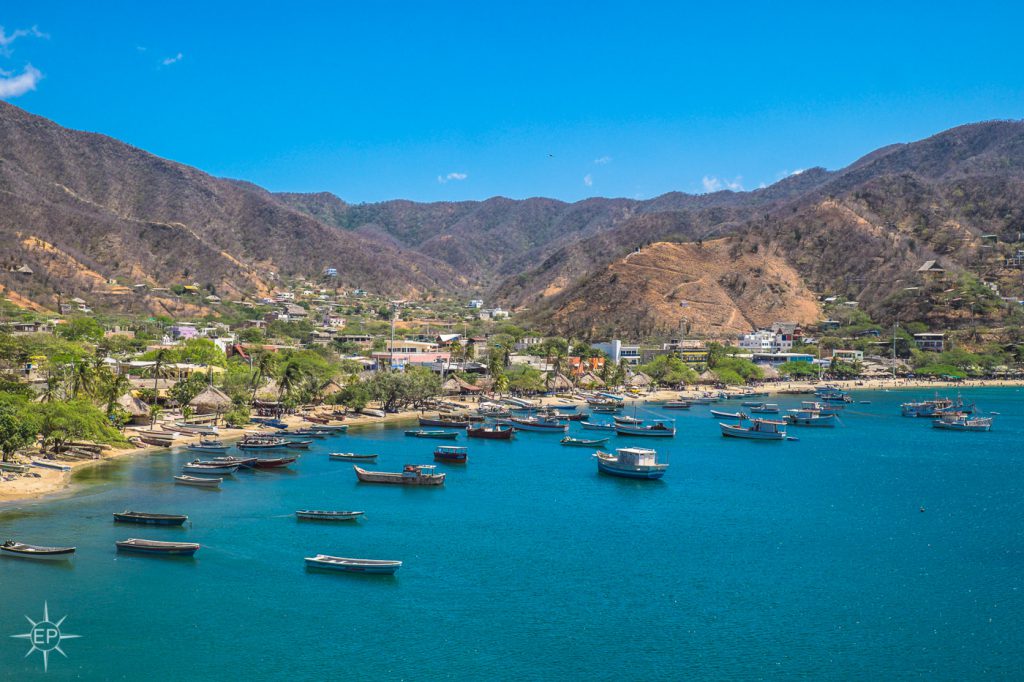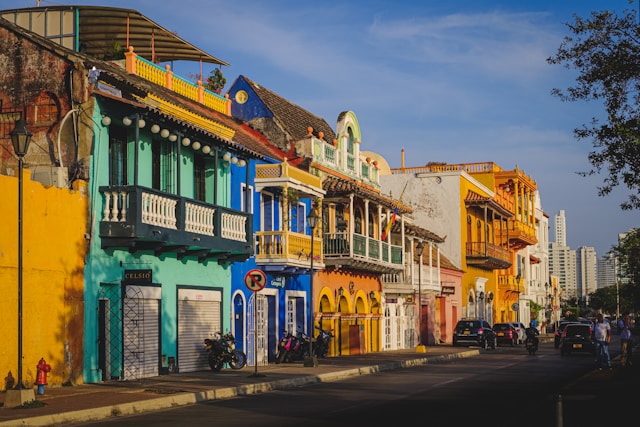UPDATED 2024 –
Welcome to our Colombia travel guide, where you will discover 10 great reasons to visit this vibrant and beautiful country.
Colombia is currently having its moment in the sun.
Gone are the days when this South American hotspot was off-limits to foreigners because it was wrought with violent crime and drug cartels.
The Colombia of today is a safe, affordable, diverse and fascinating place; its people as warm and inviting as the weather in the sweltering north.
In fact, tourism in Colombia is experiencing phenomenal growth, with almost 250% more visitors compared with 10 years ago.
The country was even named number two in Lonely Planet’s Top Countries to Visit in 2017.
Colombia’s wealth of drawcards include vibrant cosmopolitan cities (Medellin and Bogota), otherworldly landscapes (Cocora Valley) and colourful colonial buildings (Cartagena and Guatapé).
It’s got world-renowned coffee (Salento), the Amazon rainforest and an island paradise just waiting to be explored (San Andres).
This Colombia travel guide will give you an idea of the huge array of adventures waiting to be had in this fabulous destination.
For a dose of colour, culture, scenery and salsa dancing, Colombia is the place to go.
Colombia Travel Guide – Out top picks for travel in Colombia
1. Visit the Gold Museum in Bogota and get the best views of the capital from Monserrate.
Colombia’s capital, Bogota, is an eclectic mix of elegant hotels, charming neighbourhoods and gritty street art.
The Gold Museum, Museo del Oro, is one of the top tourist attractions in the country and well worth visiting.
It features a huge collection of 34,000 gold pieces and 20,000 objects from pre-Columbian cultures.
With such an expansive showcase, including the intricate la balsa muisca (the Muisca raft), it is impossible to walk through this museum and not be impressed.
Colombia travel guide tip: Visit Museo del Oro on a Sunday, when entry is free.
Also in Bogota, explore the impressive salt cathedral, visit the La Candelaria neighbourhood or take a street art tour to learn about the history and politics of graffiti in Colombia.
For incredible views of the city, ride the cable car up to Monserrate.
Monserrate mountain is known for its uninterrupted views of the city, but once you reach the top you can also visit the lovely white church or take a break at one of many restaurants.
Bogota bonus: Take a day trip from Bogota to the beautiful cobblestone village of Villa de Leyva.
With its whitewashed buildings and huge central plaza dating back to the 16th century, you’ll get a fascinating snapshot of life lost in time.
There is even a house in Villa de Leyva made entirely out of clay!
Known as Casa Terracotta and believed to be the world’s largest work of pottery, this quirky building is reason enough to visit this charming colonial village.
2. Take a stroll through pretty streets and enjoy the romance of Cartagena.
No Colombia travel guide would be complete without featuring the enchanting city of Cartagena.
Located on the Caribbean coast, Cartagena is a vibrant city with colourful colonial buildings, flower-adorned balconies, cobblestone streets and iconic fortress walls.
Cartagena’s old town features stunning architecture that makes wandering the streets in the sun a pleasant delight.
You’ll find plazas buzzing with people, from street performers to al fresco diners, markets stalls, sizzling food carts, fresh fruits and street vendors selling colourful wares.
Head up to the fortress walls, built during the late 16th century, for a cocktail at sunset before selecting from one of many fine dining establishments.
Visit the historic Castillo San Felipe de Barajas, take a boat trip to the Rosario Islands or enjoy a mud bath in the Totumo Volcano.
3. Visit Salento & Cocora Valley for the world’s best coffee and tallest palm trees.
You probably already know that Colombian coffee is among the best in the world.
So, you can’t possibly visit this country without embarking on a coffee tour in the famous coffee triangle.
Head to the gorgeous colonial town of Salento for your tour and learn about the process from bean to cup.
Explore coffee plantations, discover the differences between modern and traditional coffee and watch the beans being roasted and ground.
Most important, you will even get to enjoy a freshly roasted cafe for yourself.
While in Salento, you can also visit the Cocora Valley (Valle de Cocora), a surreal landscape where the world’s tallest palm trees grow.
These towering wax palms are Colombia’s national tree and can grow up to 60 metres in height.
4. Explore cosmopolitan Medellin and take a ride on the city’s cable car- Colombia travel guide
While Medellin was once regarded as the most dangerous city in the world, it has reinvented itself over the past two decades.
And this is great news for tourists, because the city is now an incredibly safe destination featuring vibrant neighbourhoods, fine museums and art galleries and a plethora of restaurants sand bars.
In addition, Medellin has one of the best public transport systems in the world.
Ride the Metrocable for fabulous views of this sprawling city, visit Plaza Botero with its giant outdoor sculptures or relax in the tranquil botanical gardens (Jardin Botanico).
And, while Colombia isn’t exactly famous for its food, you can still find a number of quality eateries in Medellin.
Or why not take part in a street food or exotic fruits tour?
There is certainly no shortage of things to do in the exciting metropolis of Medellin.
5. Stroll the rainbow streets of Guatapé and climb ‘The Rock’ for the best views in Colombia.
Guatapé is a unique and delightful place, unlike anywhere else you will visit.
Colombia’s most colourful town has the ability to make people happy, with every step taken down its vibrantly painted streets.
While wandering through rainbow alleyways, you can also spot zocalos – pictures etched into buildings that once depicted the occupation of its inhabitants.
Visit Guatapé on a day trip from Medellin and don’t forget to climb Colombia’s famous rock.
The Rock of Guatapé, also known as El Peñón de Guatapé, is a 200-metre high freestanding rock that can be climbed in about 15 minutes.
Although you must hike 740 stairs to reach the top, the views from above are simply breathtaking.
6. Learn how to salsa dance in Cali – Colombia Travel Guide
Everywhere you go in Cali, you will hear the infectious toe-tapping tunes of salsa music.
The self-proclaimed salsa capital of the world, this Colombian city is also the place to go to learn this famous dance style.
Take a class in one of the many dance schools, which offer private or group lessons for beginners.
Alternatively, head out to one of the local clubs to practise your moves, or sip cocktails while you watch the locals getting hot and steamy on the dance floor.
In addition, visitors can glimpse Cali legends in action through the spectacular salsa show that is Delirio.
Part dance show, part circus extravaganza, Delirio offers a visual spectacle and astounding showcase of Colombian culture that can only be experienced in Cali.
7. Enjoy the beaches of the Caribbean Coast and Colombia’s jewel, Tayrona Park.

The pretty fishing village of Taganga.
The Caribbean Coast is a diverse destination in its own right, offering pretty beaches, sleepy mountain towns, arid deserts and lush jungles.
Tayrona Park is considered the jewel of Colombia’s Caribbean Coast.
This stunning national park with its pristine beaches and thriving rainforest is the perfect location for hiking and wildlife watching.
Start in the city of Santa Marta – worth visiting for a couple of days and a great base for exploring the region.
Begin your 4-day jungle trek to the Ciudad de Perdida, or Lost City, from here, too.
About 10 minutes from Santa Marta lies the lovely fishing village of Taganga.
Much smaller, yet prettier than Santa Marta, this quaint bay is famous for its world-class scuba diving and spectacular sunsets.
A little further away, you’ll discover Palomino, which is widely regarded as Colombia’s best beach.
This stretch of almost-white sand lined with palm trees also offers accommodation right on the beach.
While in the north, you may also visit the incredible Cabo de la Vela, where the desert meets the sea.
8. Go hiking, birdwatching and visit pretty waterfalls in mountainous Minca.
Minca is a small mountain town in the north of Colombia, about 14 kilometres from Santa Marta.
An idyllic destination for couples and nature lovers, Minca is a great place for hiking, mountain biking, yoga, visiting coffee plantations and exploring pretty waterfalls.
With more than 160 species of birdlife, Minca is also offers incredible birdwatching tours.
So be sure to bring your binoculars!
Although a small rural town with little more than one main street, Minca remains very charming.
It offers a wealth of natural wonders, such as the Pozo Azul and Cascada de Marinka waterfalls.
You’ll also find restaurants with spectacular views – perfect for sipping organic coffee or cocktails and watching the world go by.
Take a scenic yoga class with Casa Yoga and be sure to visit Casa Elemento, where you can enjoy spectacular views of Minca from a giant hammock.
9. Swim, snorkel, scuba or do absolutely nothing on the island paradise of San Andres.

San Andres is a Caribbean island paradise. Photo by sanandrescolombia.com.co
San Andres must be seen to be believed.
Located some 700 kilometres from Colombia’s mainland, this Caribbean archipelago features pristine white sand beaches.
Plus, the most amazing turquoise waters you are ever likely to experience.
Hence this island paradise is perfect for diving, relaxing on the beach, practising watersports or undertaking eco-tourism adventures.
San Andres boasts 40 dive sites with an array of colourful fish and vibrant coral.
Not to mention jet skiing, kitesurfing and windsurfing catering to the adventure enthusiasts.
Due to its English, Spanish, African and Jamaican influences, this is a multicultural destination that moves to the sound of reggae music.
You’ll also find energetic nightlife here, as once darkness falls these islands come alive with music and dancing.
10. Discover the mystery and biodiversity of the Colombian Amazon.

Explore the biodiversity of the Amazon.
With some of the richest biodiversity on the planet, the Colombian Amazon offers nature, adventure and eco-tourism in one.
The Amazon region encompasses pristine rainforest, unique wildlife and largely untouched indigenous cultures who live deep in the jungle.
Glide down Amazon River tributaries by canoe, spot rare pink dolphins, stay in floating houses or visit Isla de los Micos (Monkey Island), the home of almost 5000 primates.
Access the Amazon rainforest through Leticia, which is located on Colombia’s southernmost tip.
(Note: Since Leticia is not accessible by road, you must arrive by plane or boat.)
Kayak through the Yahuarcaca lakes in Leticia, where you can spot wildlife like eagles, hawks and sloths.
In addition, this area is home to the world’s largest water lily, with leaves up to two metres in diameter.
To the north of Leticia, you can find 150 types of mammals, including jaguars and tapirs, 468 bird species and a wealth of plant life.
Extra Colombia travel guide tip – Carnival de Barranquilla
If visiting Colombia in February, you will be there to experience Carnival de Barranquilla.
Because it is the second biggest carnival in the world, half a million people flock to the city of Barranquilla each year for this four-day feast of colours, costumes, dancing and parades.
In conclusion, this is definitely one event you don’t want to miss!
So, there you have it.
Ten great reasons to visit Colombia.
Hopefully, our Colombia travel guide has helped you discover what an exciting destination Colombia is and that there is no better time to visit than right now.
Contact us for more information or to customize your unique Colombia tour.
Colombia travel guide – About Colombia
Population: 49.2 million
Capital city: Bogota
Official language: Spanish
Currency: Colombian peso (approximately 3000 COP = $1 USD)
Like it? Pin it!













